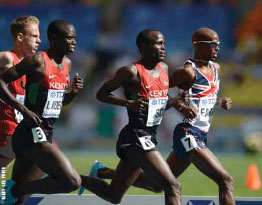| Understanding and Managing Lactate
Originally Published in Techniques Magazine Provided by - USTFCCCA
 THE PROBLEM We live in a world of fast paced competition filled with high performers and over achievers. Not surprisingly, this competitive condition is greatly magnified within the endurance community. Unfortunately, far too many people (coaches and athletes alike) have difficulty finding that ideal balance between training and recovery that maximizes the performance outputs of an individual athlete. And because the human body is so complex, training and recovery aren't really binary states of being either, but rather complements of a wider spectrum of activity. To really help athletes improve, each workout (or rest period) within a training plan must be assigned an intensity that is based on the strategy of that training plan and tailored to the individual athlete. This observation is not meant as criticism of us coaches, but serves as a commentary on how difficult it is to train right. Despite the growth of readily accessible data there remains a lingering confusion of what the best ways to train really are. At collegiate and even high school levels of performance, the literature shows that more performances are spoiled by overtraining than by undertraining. Coaching experience also confirms this. Five-time Olympic running coach Bobby McGee has observed that "an athlete who is 90 percent conditioned for an event will do better than an athlete who is 0.5 percent over-trained." So how do we as coaches come to know each athlete at such a level that we can provide the individualized service they need? Essentially, how do we help each athlete train correctly?
We have found that the strongest predictors of real-world training intensity are frequently not the true needs of an athlete, but the subjective importance of a particular race or competition. Rather than listening to the athlete's body and the body of available scientific literature, athletes and coaches continue to relentlessly push harder and harder as they perceive the stakes to rise. Far too often this dangerous approach leads to either overtraining fatigue and/or injuries. A common definition of overtraining refers to the point where an athlete starts to experience physiological maladaptations and chronic performance declines. Notice here that the technical definition begins even before injury and includes any event/ state of being which negatively impacts performance. The injurious effects of overtraining cannot be overstated and are becoming an increasingly common phenomenon. One particularly telling study reported that in preparation for the 1996 Atlanta Olympic Games, more than 28 percent of U.S. athletes reported overtraining injuries. These ranged in severity from serious injury to impaired performance. If this figure seems impressive to you, consider that it more than doubles in the general athletic population where between 66-79 percent of athletes report overtraining injuries annually. THE SOLUTION There is no single solution that can definitively rid the world of overtraining; however, the burden is on us as coaches and recognized professionals to use all reasonable efforts to prevent it from happening in our own athletic populations. Doing this consistently (and effectively) involves an intimate knowledge of each athlete and how they respond to training. It involves a combined appreciation for their fitness level, events, goals and training history. In my medical and coaching experience the best way to understand an athlete at a "molecular" level and really start to appreciate what their unique training needs are is to use lactate threshold. WHAT IS LACTATE? In order to make sense of lactate threshold, it is important to have a basic understanding of the energy producing systems in the body. Energy is supplied by the body through a series of complex chemical reactions that take the nutrients we consume and converts them into a universal currency—ATP. This ever-present molecule is then used for all energy requiring processes, including the muscular contraction of endurance running. Despite the existence of a single common currency for all biochemical activity, the human body has evolved multiple methods for producing ATP based on the amount, intensity, and duration required. The general rule we all learned in high school is that aerobic metabolism fuels periods of sustained, moderate activity and anaerobic metabolism is used for short periods of high demand. The truth is that the energy producing systems are complex and highly interrelated. Both work together in a dynamic environment to produce the energy our bodies need both during exercise and at rest. As the intensity or speed of a workout increases, energy production needs to occur more rapidly and in greater volumes. In this state the body relies more heavily on the anaerobic energy system to overcome the functional deficit of what aerobic metabolism can generate. A by-product of anaerobic metabolism is lactate. Contrary to what you may have read though, lactate (or lactic acid if you add a hydrogen) does not deserve all of the negative press it has received. We now know that lactate is not the cause of muscle soreness and the fatigue that occurs during training but is in fact a metabolic intermediate that can both help reduce increasing levels of acidity and also serves as a secondary source of fuel for the rapidly contracting muscles. In other words, lactate is actually a good thing. We continue to talk about lactate in the athletic community because it is an important molecular marker for performance related events. We now know that accumulating lactate does in fact indicate increasing acidity within the muscle, but is not the perpetrator as we once thought; it is instead a measurable surrogate marker for the same event. In medicine we use surrogate markers an the time to measure important biologic events we otherwise couldn't quantify. When we want to know how the kidney is functioning we measure creatinine instead; when we want to assess liver health and/or toxicity we look at the transaminases. By measuring lactate, a coach is simply applying the same rigor a physician would use to help him or her understand the body system of their primary interest. LACTATE THRESHOLD Lactate levels dynamically change based on both rates of production and removal. As long as lactate removal capabilities exceed the rate of production, levels remain relatively low. This is why during low intensity training, even training of extended duration, lactate levels do not increase significantly. But once production increases above the maximum clearance rate, lactate begins to accumulate. This point is known as lactate threshold (LT). Because of the increasing level of intracellular acidity, athletes can only exceed lactate threshold pace for a limited amount of time before fatigue forces them to slow down. Research shows that well trained athletes can typically maintain LT pace for approximately 45 minutes to an hour. Because of its tight correlation with endurance performance, lactate threshold has been shown to be the most powerful monitoring technique available. It can be used with great accuracy to define the appropriate training intensities of each athlete and then quantify their improvements over a training season and over a career. THE BENEFIT A series of recently conducted independent studies have illustrated the usefulness of lactate threshold for understanding race performance. In one such study, a large cohort of elite 10-kilometer runners had their lactates measured just prior to start. The researchers then made predictions of race finish order simply by ranking athletes based on their lactate thresholds. Once the race was completed, the actual results were then compared with what had been predicted. They had been able to predict the actual finish order with an impressive 93 percent accuracy. These results generated significant interest in lactate threshold and subsequent studies have further validated these findings. Further attempts to improve LT using simple statistical analysis have improved its prediction correlations up to 95-97 percent. AN OPPORTUNITY With the emergence of new wearable technologies the opportunity for noninvasive, simple testing remains a tantalizing option. It will be interesting to see how performance monitoring changes in the next several years and what technologies will participate in building the next generation of elite athletes. BIO Dustin Freckleton, MD, received his medical degree from the University of Texas Medical School at Houston and has an extensive research background in health and human performance. He has served as an instructor at the USATF National Podium Education Project and is a USATF level 1 certified coach. In 2012 he co-founded BSX Athletics, a sports technology company that combines wearable technology with real-life coaching to help improve athletic performance. |




 THE IMPACT
THE IMPACT



